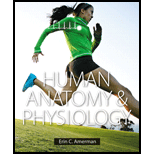
Concept explainers
To review:
Match the terms microtubules, intermediate filaments, or actin filaments with the most closely related descriptions given below:
(a) Thinnest cytoskeletal filaments; are associated with motor protein myosin.
(b) Consists of proteins twisted together in a rope-like form
(c) Allow certain cells to “crawl” and change the shape and the size of the cell
(d) Consists of protein subunits surrounding a hollow core
(e) Help a cell to resist mechanical stress
(f) Grow from the cell’s centrosome
Introduction:
The microtubules, intermediate filaments, and the actin filaments belong to the cytoskeleton of the cell. The cytoskeleton is composed of the different types of the protein filaments, which are organized according to their functions.
Want to see the full answer?
Check out a sample textbook solution
Chapter 3 Solutions
Human Anatomy & Physiology
- Match each of the following to its role in the cell. Microtubules Actin Tubulin Intermediate filaments Kinesin Dynein Myosin Centrosome A. Cytoskeletal fiber that is intermediate in diameter and very sturdy. Does not form from polymerization of protein monomers like the other ones we discussed in class, but consists of polypeptide strands. Keratin and Lamin A are examples. B. The structure that initiates polymerization of new microtubules and anchors microtubules in the center of the cell near the Golgi Complex. C. Motor protein whose activity results in contraction of muscle. D. Thinnest cytoskeletal filament. Responsible for initiation of amoeboid cell movement via pseudopod formation. E. The "monomer" unit of the thickest cytoskeletal polymer; a dimer of two polypeptide subunits. F. Cytoskeletal structure with the…arrow_forwardGive two examples of biological functions that are enabled by microfilaments or microtubules together with associated motor proteins.These could be whole cell functions or functions within the cell.arrow_forward(a) If you were to magnify a cell 10,000-fold (typical of the magnification achievedusing an electron microscope), how big would it appear? Assume you are viewing a“typical” eukaryotic cell with a cellular diameter of 50 μm.(b) If this cell were a muscle cell (myocyte), how many molecules of actin could ithold? Assume the cell is spherical and no other cellular components are present; actinmolecules are spherical, with a diameter of 3.6 nm. (c) If this were a liver cell (hepatocyte) of the same dimensions, how manymitochondria could it hold? Assume the cell is spherical; no other cellular components arepresent; and the mitochondria are spherical, with a diameter of 1.5 μmarrow_forward
- a) Are actin filaments subject to the same "dynamic instability" as microtubules? Yes or no? b)Explain how both actin and microtubules polymerize and depolymerize.arrow_forwardList the three types of filaments associated with the cytoskeleton. Identify the structures in cells that are composed of microtubules.arrow_forwardIn animal and yeast cells, it appears that these vesicles travel from the main cell body to the region where the new division is forming by moving along actin filaments. What type/family of motor protein might you expect to be associated with these vesicles to facilitate this transport? Briefly explain your reasoning.arrow_forward
- Which of the following describes an F-actin microfilament? A flexible, helical filament composed of two strands assembled from G-actin 13 protofilaments composed of heterodimers with a hollow core a flexible filament composed of 13 interwoven protofilaments Eight tetramers twisted into a rope-like filamentarrow_forwardExplain how the structure of intermediate filaments makes them better suited to provide mechanical strength than either microtubules or actin filaments.?arrow_forwardSome genetic diseases cause deficient activity of lysosomes. What would be the direct consequence of these diseases? a.Fewer macromolecules within the cytosol. b.Less degradation of old organelles. c.Increased hydrolysis of macromolecules. d.Reduce rate of endocytosis.arrow_forward
- Which of the following statements are true for both actin and tubulin: a. Both actin and tubulin filaments are hollow. b. Both actin and tubulin are structural proteins capable to form filaments that can grow from both (+) and (-) ends. c. Both actin and tubulin require GTP for polymerization into filaments. d. Both actin and tubulin require ATP for polymerization into filaments.arrow_forwardFrom the image, what is the normal function of the missing structure? A. A lipid bilayer controlling the movement of substances into and out of the cell B. A motor protein that "crawls" along microtubules to contract and release them, which provides movement C. A cytoskeleton element composed of tubulin subunits to provide structure for movement of the cellarrow_forwardActin and microtubules have polarity, intermediate filaments have no polarity. What is the main consequence of this difference?arrow_forward
 Human Physiology: From Cells to Systems (MindTap ...BiologyISBN:9781285866932Author:Lauralee SherwoodPublisher:Cengage Learning
Human Physiology: From Cells to Systems (MindTap ...BiologyISBN:9781285866932Author:Lauralee SherwoodPublisher:Cengage Learning
